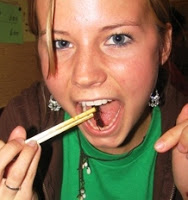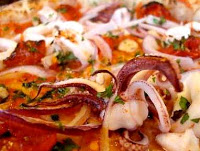From Sept. 2013: In case you’ve been anxiously waiting, somebody has released the revised edition of 40 Ways to Cook Crickets, Grasshoppers, Ants, Water Bugs, Spiders, Centipedes, and Their Kin.
The media is crawling with reports about the UN recommendation that we all consider eating insects. Apparently, two billion people already do–and that doesn’t count those of us who involuntarily suck in bugs while biking on warm summer days. Edible insects are being promoted as a low-fat, high-protein food that comes with appetizing side benefits: Reducing greenhouse gas emissions and livestock pollution, creating jobs in developing countries, and feeding hungry people around in the world.
 |
|||
| Glazed, stir-fried grasshopper |
Eyeballs on the menu? This npr article points out that they are taboo for many, but in some countries, diners can “see eye to eye” with the idea. Maybe eyeball consumption gets a blank stare from diners because of the texture or perceived taste, but some experts says it is because eyeballs represent faces–and some cultures have a thing about eating anything that’s looking at them.
I may have eaten eyeballs in some dish or another along the way, and I’ve certainly been served whole fish on many occasions. But when it came to the head, I checked out the cheeks, not the eyeballs. A friend who liked to fish told me years ago that a little pocket of fatty meat in the fish cheek is the best part, and after my non-scientific, random research, I’d say he’s right.
The eyeball article got me thinking about food preferences around the world, and this entry I wrote from November of 2011 captures some of the varied fast-food items that are dished out–from a Rugby Burger to a McGrillschnagg.
McSquid Burger? Menu Globalization Works Both Ways
A recent online story highlights the obvious: Tastes around the world vary. And even though major fast-food companies appear to be homogenizing the world with a one-size-fits-all product, they occasionally bend to local customs and sometimes benefit from taking their menus outside the box. The MSN article, “Ten Fast Foods You Can’t Buy Here,” shows food items that major companies have modified to appeal to local tastes outside the United States. Subway outlets in India offer curry and tandoori flavors in their sandwiches; Pizza Hut’s Chunky Loaded Pizza in Malaysia has so many layers, some think of it as a casserole; and Burger King’s dessert in Holland, The Hot Blondie, might not be politically correct to everyone, but the brownie, chocolate, and ice cream mix would probably appeal to most taste buds.
 |
| Squid Pizza |
I should have jumped on this trend years ago. My wife and I spent four years in Australia during the 70s, and we knew we weren’t in Iowa anymore when the burgers we ordered came with “the works.” Aussie grass-fed beef patties were topped with lettuce, tomato, onion, a fried egg, and beetroot; some snack bars in the Outback added baked beans and mashed potatoes. I needed a funnel to get it in my mouth without losing half of it. So now in the online article I see that Wendy’s in New Zealand stacked up a similar formula and called it a Rugby Burger. I’m not sure how many in the United States would scrum up for a burger garnished with beets.
Your donation to CAST helps support the CAST mission of communicating science to meet the challenge of producing enough food, fiber and fuel for a growing population. Every gift, no matter the size, is appreciated.